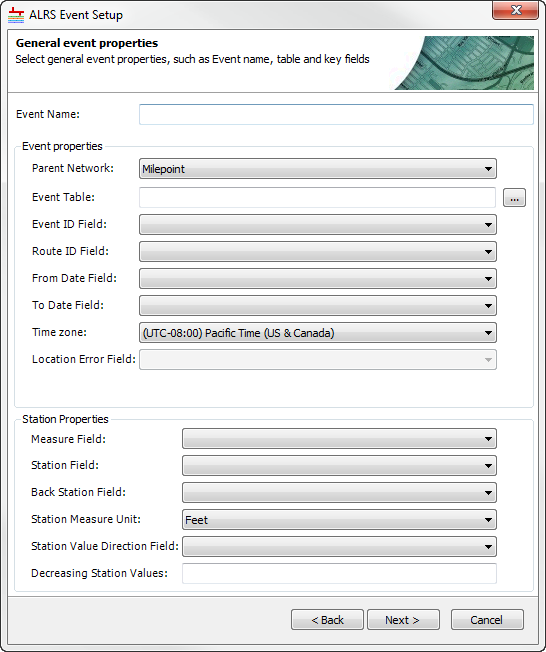Registration of a stationing event type is used if you plan to use stationing as a method for creating and editing events within your ALRS. Registering a stationing event layer allows you to locate stations with ahead and back station values at any measure along a route in your LRS Network. These stations can then be used to create and edit events on your network.
This operation requires that you register an event using source data such as a table, feature class, Microsoft Access database, or Excel spreadsheet. If the event being registered is a feature class, Roads and Highways uses the provided feature class and also provides an option to regenerate the shapes or use the existing shapes as is. Once the event feature class is created, it becomes the authoritative source for the event data. If the event being registered is not a feature class, Roads and Highways will create a feature class with the prefix LRSE. This LRSE feature class becomes the authoritative source for the event data and should be used when creating an MXD for use in the Roadway Characteristics Editor. The source event used for registration is no longer needed within Roads and Highways.
During the registration process, Roads and Highways slices events into different features to provide support for temporality and honor the changes in route shape and measures across time. Desktop editing of the event shapes using the ArcGIS editing tools is not supported. Roads and Highways will take care of managing and generating event shapes based on changes to the event's Route ID, measures, from date, to date, or changes to the route with which the event is associated.
- Start ArcMap and open the Catalog window or start ArcCatalog.
- In the Catalog tree, connect to the geodatabase that contains the ALRS and LRS Network for which you want to register event layers.
- Expand the ALRS that contains the LRS Network for which you want to add event layers.
- Right-click the LRS Network and click New > LRS Event.
The ALRS Event Setup wizard appears.

- Click Next.

- Click Station.
- Click Next.
The General event properties dialog box appears.

- Type the name of your event layer in the Event Name text box.
- Verify the parent network is set to the correct network.
- Click the browse button next to the Event Table text box.
The Browse Data dialog box appears.

- Browse to the business table for which you want to create an event layer and click Select.
The General event properties dialog box is populated with information from the event table.

- Verify and update the rest of the information on the General event properties dialog box, as needed.
- Click the Event ID Field drop-down arrow and select a value.
- Click the Route ID Field drop-down arrow and select a value.
- Click the From Date Field drop-down arrow and select value.
- Click the To Date Field drop-down arrow and select a value.
- Click the Time zone drop-down arrow and select a value.
By default, the Event ID Field value is used as the primary key when the From Date Field and To Date Field values are not defined.
If the From Date Field and To Date Field values are defined, the primary key uses a combination of the Event ID Field, From Date Field, and To Date Field values.
If the external table supports the Roads and Highways temporality model at the time the event is created, specify the From Date Field and To Date Field values.
If the From Date Field and To Date Field values are not provided, Roads and Highways assumes that the external table does not support temporality and expects only one entry per event. In this scenario, the Event ID column is treated as unique.
Ensure the values in the FromDate and ToDate columns are not conflicting.
Regardless of whether external event tables support temporality, the staging table will always contain FromDate and ToDate columns.
- Set the Measure field.
- Set the Station field.
This field accommodates the Ahead Station values. You can also use this field to populate the station values when the station equations are not present.
- Set the Back Station field.
- Click the Station Measure Unit drop-down arrow and choose the units for your data.
- Click the Station Value Direction drop-down arrow and choose the field.
This field contains attributes that indicate the direction of increasing stations, whether the station values increase toward the direction of calibration of the route or not.
- Type the values representing a decrease for your data in the Decreasing Station Values text box.
You can type multiple comma-separated values in this text box. The values in the Station Value Direction field indicate that the station values decrease toward the direction of calibration of the route. A blank value or no value indicates that the station values increase toward the direction of calibration of the route.
- Click Next to set event behavior.
For more information about setting event behavior, see Event behaviors.
- Click Finish.